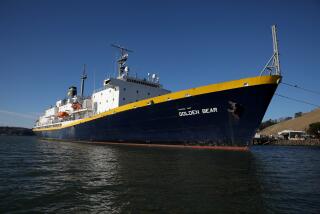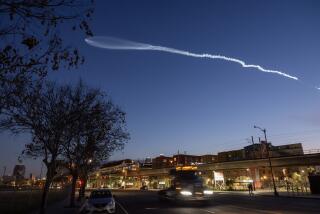Navy Sees Red Herring in America’s Cup Regatta : Espionage: It worries that spies and animal activists will target dolphin and seal-training programs during 1992 yacht races.
- Share via
Navy officials are so concerned about foreign spies infiltrating the America’s Cup yacht race in San Diego waters in 1992 that they are considering moving or suspending the carefully guarded dolphin and sea lion program, according to an internal document obtained by The Times.
Navy officials also are worried about press scrutiny that might result in adverse publicity about the marine mammal program, which has drawn considerable fire from animal rights activists.
The “Marine Mammal System will be subject to constant observation by foreign operatives and international participants affiliated with these (racing) syndicates,” according to the memo. “Of greater concern is the inevitable national and international press interest.”
Navy officials “anticipate only negative press coverage of the Marine Mammal System programs. Presence of national/international press corps provides excellent opportunity for animal rights/Greenpeace activists to gain maximum media exposure.”
The internal document was written by a top-ranking officer with the San Diego-based Ordnance Demolition command and sent to the Chief of Naval Operations in Washington on July 3.
From January, 1991, to June, 1992, 24 yachting syndicates will sail San Diego waters to train and compete in the 28th America’s Cup. The syndicates come from 15 countries, including two from the Soviet Union and one from Yugoslavia.
Organizers expect the race to draw 4,500 journalists and 1 million visitors. Navy officials fear that some of those visitors taking to the water will approach the Navy’s pens containing the secretive Marine Mammal System, about half a mile south of Shelter Island along Point Loma near the entrance to San Diego Bay.
Navy officials are considering several options, including shutting the program down until June, 1992, or relocating the marine mammals. Experts are evaluating the cost of relocating the marine mammals, said Cmdr. Doug Schamp, a Navy spokesman.
“What you are seeing are the concerns of one command. They are valid concerns,” said Schamp, who acknowledged that many San Diego branches of the Navy are concerned about Soviets visiting the city.
Soviet vessels are not allowed into San Diego ports unless they have obtained waivers, Schamp said. And Soviet officials are not allowed to visit the city unless they have obtained permission.
Last October, the FBI asked San Diego residents to beware of Soviet citizens visiting during the city’s Soviet Arts Festival. The guests, they warned, could use the festival to prowl the city and dupe citizens into revealing secrets. FBI officials later said that Soviet spies did attend the festival under the guise of stagehands.
“We expect an espionage team to do some targeting--we would do the same thing, given the opportunity,” said one Navy officer, who requested anonymity. “The end of the Cold War means you are going to have friendly relations, and you are going to know a lot more about each other. We are trying to be smart about it and protect as much information as we can in case relations don’t remain cordial.”
Officials with the race, however, say they do not believe the event will endanger Navy secrets.
“The courses are not anywhere near where the the Navy keeps their mammals, so I don’t know what the concern is except the traffic in the bay,” said Pete Litrenta, in charge of military relations for the America’s Cup Organizing Committee.
Race officials worked closely with the Navy, Coast Guard and Federal Aviation Administration in hammering out three courses that will be used, Litrenta said.
Litrenta, a former Navy spokesman, also dismissed the Navy concerns about adverse publicity, saying: “Just because the American’s Cup is going to be here, doesn’t mean the Marine Mammal program is going to get publicity. The Navy should be secure enough about their program in terms of how the animals are treated and so forth as to justify and defend the program.”
The Navy’s program uses marine mammals for underwater surveillance and to detect, mark and recover objects, said Tom LaPuzza, spokesman for the Naval Ocean Systems Center in San Diego. LaPuzza declined to elaborate, saying the program is classified.
“We are very concerned about any disruption in training” that might result from activists’ protests, LaPuzza said.
According to the memo obtained by The Times, Navy officials are concerned that spies might learn more about the swimmer detection system that uses dolphins to detect and mark hostile swimmers; the ordnance recovery system that uses sea lions; and the mine detection and neutralization systems that uses dolphins to detect and defuse short-tethered moored mines as well as buried mines.
The Marine Mammal System has 141 mammals at four bases: the Amphibious Base and Naval Ocean Systems Center in San Diego, one in Hawaii and one in Florida. The mammals include 100 Atlantic bottle-nose dolphins, 7 Pacific bottle-nose dolphins, 2 Atlantic-Pacific mixed breed dolphins, 26 California sea lions, 3 Beluga whales, 2 Risso’s dolphins and one false killer whale.
In recent months, animal rights advocates, who accuse the Navy of abusing the animals, have threatened to break pens and free the Navy’s marine mammals in Florida. An activist and a film crew for the television program “Inside Edition” were arrested for filming dolphins last month.
San Diego, the site of the mammals’ “boot camp,” has the largest share--about 50%, said LaPuzza. To protect the training facilities, the Coast Guard created a restricted zone north of Ballast Point that stretches 700 yards from shore, from buoy 15 to the Naval Supply Systems’ fueling pier.
The location of the facility is no secret. Excursion boats frequently toot by, and tour guides point it out.
“The pens aren’t hidden from the public--we don’t put a blanket over them,” LaPuzza said. “You can ride right by.”
More to Read
Sign up for Essential California
The most important California stories and recommendations in your inbox every morning.
You may occasionally receive promotional content from the Los Angeles Times.










